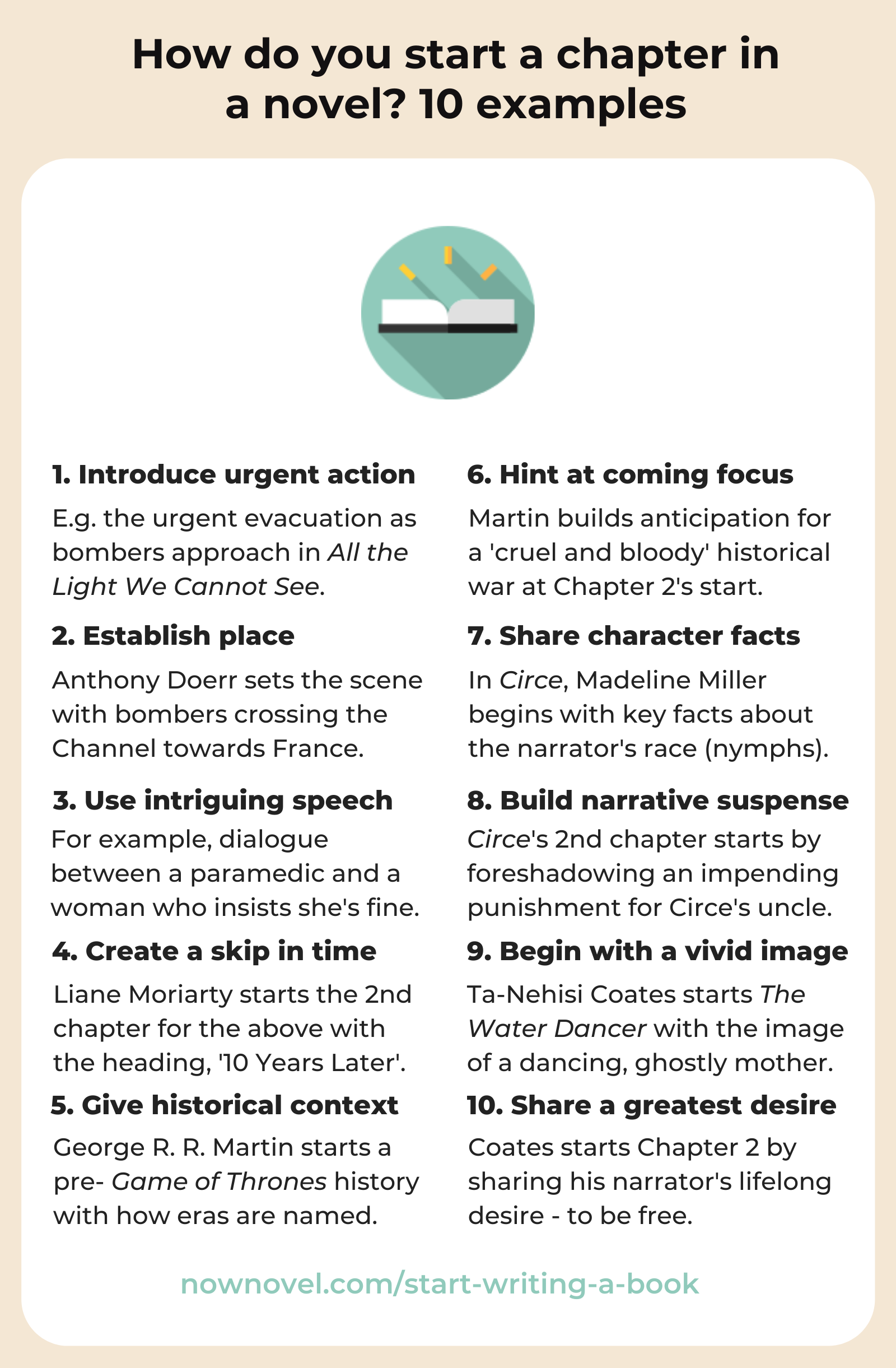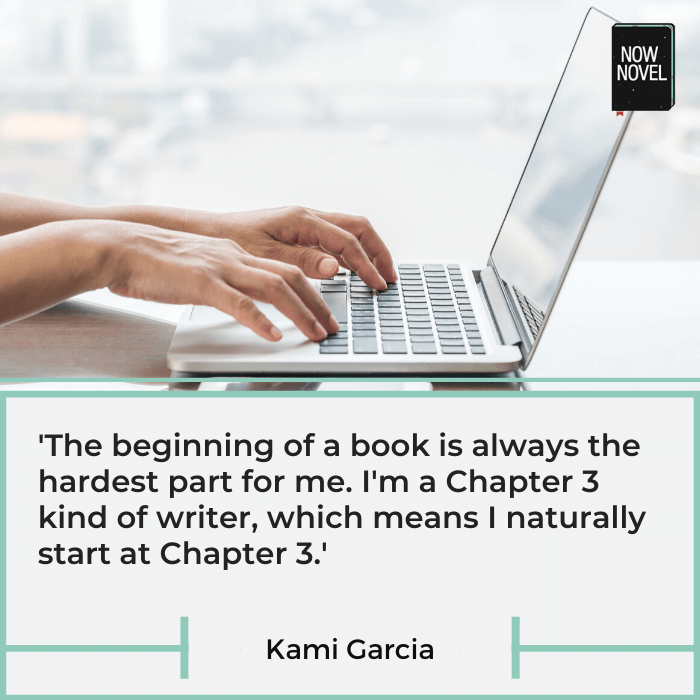How do you start a chapter in a novel to hook your reader and structure your story? These 10 examples reveal ways to make your chapter beginning count:
1. Introduce urgent current or impending action
Consider the opening paragraph to the first chapter of Anthony Doerr’s Pulitzer-winning wartime novel, All the Light we Cannot See, titled ‘Leaflets’:
At dusk they pour from the sky. They blow across the ramparts, turn cartwheels over rooftops, flutter into the ravines between houses. Entire streets swirl with them, flashing white against the cobbles. Urgent message to the inhabitants of this town, they say. Depart immediately to open country.
Anthony Doerr, All the Light we Cannot See (2014), p. 3.
Doerr’s opening is compelling because it introduces both compelling current action (the leaflets raining from the sky) and important impending or coming action (the urgent evacuation before the city is bombed).
The opening paragraph tells us what important things are happening right now, and hints at an approaching, mysterious situation (we don’t yet know, at this point, exactly why the town’s inhabitants must evacuate).
[Start your story with easy step-by-step outlining prompts that will help you gather and organize your ideas.]
2. Establish place
Establishing where your story unfolds is important. Sometimes, you might want your reader to be disoriented (if your protagonist is in an isolation tank, for example).
Most of the time, though, giving the broad scope of where we are at this point in the story helps anchor events to a place.
The reader has the key information they need to picture things clearer. Consider the opening of Doerr’s second chapter, titled ‘Bombers’:
They cross the Channel at midnight. There are twelve and they are named for songs: Stardust and Stormy Weather and In the Mood and Pistol-Packin’ Mama. The sea glide along far below, spattered with the countless chevrons of whitecaps. Soon enough, the navigators can discern the low moonlit lumps of islands ranged along the horizon.
Doerr, p. 4.
France.
All the elements of setting to establish a scene are here: Place (the Channel between England and France). Time: Midnight. Movement and direction through place: Across (the Channel). Towards: The French islands.
3. Begin an intriguing conversation
Lianne Moriarty, author of the hit novel Big Little Lies that inspired the HBO series of the same name, is a master of creating tension through various means.
Dialogue is one such vehicle for building tension, as chapter 1’s beginning in her novel Nine Perfect Strangers shows:
‘I’m fine,’ the woman said. ‘There’s nothing wrong with me.’
She didn’t look fine to Yao. It was his first day as a trainee paramedic. His third call-out.
Lianne Moriarty, Nine Perfect Strangers (2018), p. 2.
Moriarty throws us in the deep end, with two characters who we know very little about, mid-conversation.
She sets up an intriguing situation immediately, however, with the details she does reveal. Yao is a paramedic and the woman (we understand through context – because the woman says ‘I’m fine’) is the person he’s been called to respond to.
Dialogue is a great tool for establishing narrative tension. Here, tension grows for multiple reasons. Firstly, because it’s implied there’s something wrong with the woman (something urgent enough to require a paramedic). Secondly, because of the contradiction between Yao’s presence and the woman claiming she’s fine.
Outline Chapters in Easy Steps
Start brainstorming for free and get story outlining tools to organize scenes and chapters when you upgrade.
LEARN MORE
4. Create a skip in time
In Moriarty’s novel, nine strangers (as the title implies) get together at a wellness retreat where the program becomes a little suspect.
Moriarty begins chapter 2 with a flash forward to 10 years later. The chapter has two subheadings: Ten Years Later, followed by a character’s name: Frances.
Chapter 2 begins with context-giving information about Frances:
On a hot, cloudless January day, Frances Welty, the formerly bestselling romantic novelist, drove alone through scrubby bushland six hours north-west of her Sydney home.
Moriarty, Nine Perfect Strangers, p. 6.
Because Moriarty gives the anchoring setting information that what happens next is 10 years after the first chapter’s events, we have some connection between the events of chapters one and two. Even though the full extent of their connection is not yet clear (that Frances has signed up for a wellness retreat founded by the woman of Chapter 1).
This is one of the great pleasures of storytelling: You can leap over days, months years, and come back to earlier times.
Your story doesn’t have to follow a linear path in time, and you can use this to create intrigue about the unwritten gaps between events, or to slowly fill in your story’s pieces out of linear time.

5. Give historical context
Just the same as it’s sometimes interesting to leap forwards in time, as Moriarty does, sometimes it’s interesting to leap back in time.
This is particularly so for historical fiction, such as George R. R. Martin’s history of Westeros, the world of Game of Thrones.
Martin begins Fire and Blood: A history of Targaryen Kings from Aegon the Conqueror to Aegon III thus:
The maesters of the Citadel who keep the histories of Westeros have used Aegon’s Conquest as their touchstone for the past three hundred years. Births, deaths, battles, and other events are dated either AC (After the Conquest) or BC (Before the Conquest).
George R. R. Martin, Fire and Blood (2018), p. 2.
By beginning with the dating system used by his world’s historians, Martin creates the feeling of a factual history book.
The chapter beginning gives us the grand sweep of time, after which the accounts of individual deeds and acts give more detail. There’s thus a good structure, from starting broad to narrowing down to individual, illustrative incidents.
6. Hint at the focus of coming narrative
How do you start a chapter in a novel so that your reader has a vague idea of what’s coming, yet is intrigued for events to pull into sharper focus?
George R. R. Martin begins his second chapter by hinting at the nature of the approaching story:
The long reign of King Aegon I Targaryen (1 AC-37 AC) was by and large a peaceful one … in his later years, especially. But before the Dragon’s Peace, as the last two decades of his kingship were later called by the maesters of the Citadel, came the Dragon’s wars, the last of which was as cruel and bloody a conflict as any ever fought in Westeros.
Martin, Fire and Blood, p. 26.
Martin’s description of the Dragon’s wars as a ‘cruel and bloody’ conflict tells the reader the narrative is about to show the dramatic details of said conflict.

7. Share interesting character facts
The start of a chapter is a great moment to introduce a memorable character.
Many novels written in the form of autobiography begin with the narrator’s birth – from Dickens’ David Copperfield to Salman Rushdie’s Midnight’s Children.
Madeline Miller’s Circe is a retelling of the life of the enchantress of the title, a figure in Homer’s Odyssey who turns Odysseus’s men into swine when they venture onto her island.
Miller begins:
When I was born, the name for what I was did not exist. They called me nymph, assuming I would be like my mother and aunts and thousand cousins. Least of the lesser goddesses, our powers were so modest they could scarcely ensure our eternities. We spoke to fish and nurtured flowers, coaxed drops from the clouds or salt from the waves. That word, nymph, paced out the length and breadth of our futures. In our language, it means not just goddess, but bride.
Madeline Miller, Circe (2018), p. 2.
This paragraph gives us interesting facts about Circe – that she is a nymph, and that what defines this group is being a ‘lesser goddess’ with ‘modest powers’.
There is also the inference that in the years since Circe was born, the name for what she is has appeared. We thus get both interesting facts about the cultural context Circe is born into and the suggestion that her world has changed in many ways since then.
8. Build narrative suspense
This connects to the first heading (introducing urgent current or impending action).
Miller creates suspense by creating the expectation of a punishment at the start of chapter 2 in Circe:
Word came that one of my uncles was going to be punished. I had never seen him, but I had heard his name over and over in my family’s doomy whispers. Prometheus.
Miller, Circe, p. 14.
Miller makes us wait to learn what the punishment is, and what it is for. We quickly learn it’s the mythical figure Prometheus’s punishment for stealing fire from the Gods.
Structuring chapter openings for suspense this way – teasing partial information – keeps readers curious and engaged.
9. Begin with a vivid image
Many strong chapters begin with a single vivid image. For example, the shackled narrator in Ta-Nehisi Coates’ The Water Dancer recalling his mother’s being taken away:
And I could only have seen her there on the stone bridge, a dancer wreathed in ghostly blue, because that was the way they would have taken her back when I was young, back when the Virginia earth was still red as brick and red with life, and though there were other bridges spanning the river Goose, they would have bound her and brought her across this one, because this was the bridge that fed into the turnpike that twisted its way through the green hills and down the valley before bending in one direction, and that direction was south.
Ta-Nehisi Coates, The Water Dancer (2019), p. 3.
The haunting image of the mother as ‘a dancer wreathed in ghostly blue’, and as being bound and ferried across a bridge, is a powerful beginning to the story.
10. Start with a character’s greatest desire
Motivations are powerful. Motivations set stories in motion. Beginning a chapter by stating a character’s desire is a simple and effective way to show what drives your character, what undertow pulls them towards certain choices.
For example, read how Coates begins his second chapter, conveying the deep desire of a captive person:
All my life I had wanted to get out. I was unoriginal in this – all the Tasked felt the same. But, separate from them, separate from all of the Lockless, I possessed the means.
Coates, The Water Dancer, p. 15.
We immediately have an insight into one of the narrator’s deepest desires. The reader understands in this moment what drives the narrator.
Want help beginning and developing your story? Join Kickstart your Novel for feedback on your first three chapters and story plan, which you’ll create with a writing coach’s support.


7 replies on “How do you start a chapter in a novel? 10 examples”
I need to say you are the best guys. Jordan, you are the man. I just love this text, your content is just amazing. I have been reading it over and over again. Thank you!
Hi Eleize, thank you for your feedback, I’m glad to hear you’re enjoying our blog. It’s a pleasure.
its good, any novel chapter one up to three if possible, please!
I have to say I’m editing my draft and this helps out a lot. It helps me figure out what I have done properly and what needs to be fixed.
Hi NanOtaku, that is great to hear, I’m glad. Good luck with your editing further and thanks for reading Now Novel’s blog and sharing your feedback.
I need someone to edit my fiction story. This is my first novel.
Dear Garry, Now Novel also offers an editing service to writers. You can find all the details at: https://www.nownovel.com/editing
Good luck with your writing.